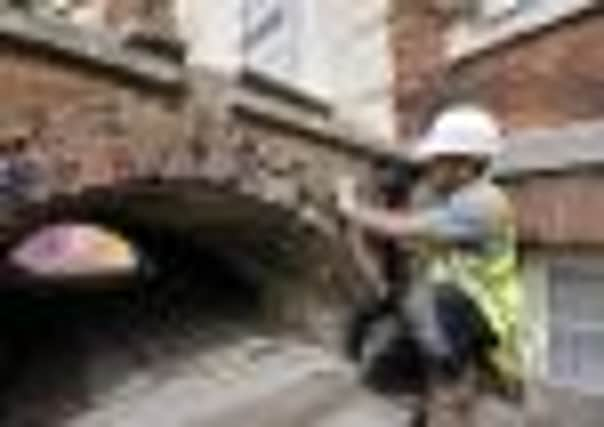Traditional approach will save crumbling bridge


The South Bridge at Beningbrough Hall has been at risk of collapse after almost 300 years of use.
But a grant from the Wolfson Foundation, along with money from the hall’s owner, the National Trust, meant specialist conservation work could begin yesterday.
Advertisement
Hide AdAdvertisement
Hide AdIt will see the bridge dismantled piece by piece over a period of 12 weeks to allow structural problems to be corrected and damage to be repaired using traditional methods. The work should be completed in October.
Building surveyor John Moorey, who has worked in the area for 12 years, said concern had grown over the state of the bridge in recent years.
“It’s fair to say we’ve been keeping an eye on it certainly for the past decade,” he said.
“We have been aware of the distortion in it for some time. The railings were covering in jasmine for about 100 years until 2005 when we took it down and the railings were badly cracked.
Advertisement
Hide AdAdvertisement
Hide Ad“It’s the last two winters when it has started to deteriorate badly. The winter before last, there was quite a hard frost when the bricks were saturated and we lost a significant chunk of brickwork.
“That’s what prompted us to get it done sooner rather than later.”
Like many people who come to Beningbrough, Mr Moorey has a personal reason for wanting the bridge to be restored. He was married at the hall in 2005 and, as with many couples, the bridge formed an attractive setting for the newlyweds’ photographs.
Traditionally, however, it would only have been women using the bridge.
Advertisement
Hide AdAdvertisement
Hide AdGeneral manager Holly Brett said: “The south bridge and adjoining steps would have once been used by the ladies of the house as a rather grand entrance from the hall out into the gardens.
“Today, however, you can see where the age of the property is now working against it. Historically there has been a settlement in the main structure of the hall; this has now caused it to drop lower than the steps.
“What we see today is a distortion in the brick arch of the bridge and this causes it to slope down.”
As well as restoring the bricks, the project will include conservation work on the limestone doorcase and the railings to the steps. It will also offer the opportunity to correct a decades-old problem with the way the bridge leans towards the house, causing water to pool between the two.
Advertisement
Hide AdAdvertisement
Hide AdWhen any work is done, it is also a chance to find out more about the hall’s history and this will be no exception, with archaeologists on hand to watch what is uncovered as the bridge is dismantled. They will also be investigating whatever is revealed as the York stone is removed from the light well in order to make improvements to the drainage.
The project is expected to cost around £140,000, with £50,000 coming from grant-giving charity the Wolfson Foundation.
Beningbrough has already seen some significant changes. Around eight years ago, a new lift was installed – a feat not often achieved in historic houses – to improve access to the upper floors of the mansion. The space was created through some 1970s bathrooms meaning the traditional features were largely unaffected.
With the house and bridge both built at the same time, around 1716, Mr Moorey said there was always conservation work to be done and he was hopeful of more funding in the future.
Advertisement
Hide AdAdvertisement
Hide AdAmong the hall’s immediate problems is another crumbling limestone doorcasing on the north side of the property, matching that on the south side by the bridge, and a light well which has been in need of attention for several years.
One of Mr Moorey’s own wishes is to restore a traditional lever system which used to operate a set of gates, which are now operated manually.
“That was quite innovative,” he added. “If we could restore that, it would be very special.”